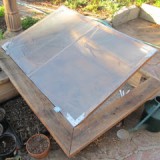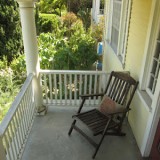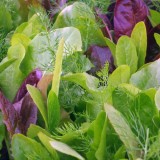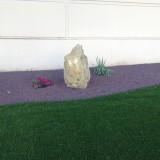Last year my tomato seeds failed to germinate. Why? It was just too cold.
I vowed to build a cold frame and this winter I made good on that promise. I’ve upgraded the plastic sheeting on the “germinator” to rigid plastic awning material (plastic sheeting over a flat surface doesn’t do well in rain . . . duh). If I were to build this thing again I’d construct a sloping top, especially if I lived somewhere with actual weather.
 |
| Before–plastic sheeting on a flat surface–a bad idea! What was I thinking? |
The automatic vent lifter (available from Peaceful Valley Farm and Garden Supply) works great, popping open the germinator to keep the seedlings from frying during the day (remember this is Southern California).
The sight of my tomato seedlings was a highlight of the week:
If I lived in a colder climate I might consider incorporating a compost bin inside my cold frame to keep seedlings warm, a heat mat, or growing indoors under lights.








How would you go about incorporating a compost bin inside the cold frame? Maybe that would call for a whole post to explain. One year, I threw uncomposted kitchen material into a five gallon bucket and planted tomatoes right on top of the compost material. Is your idea the same?
I love the idea of incorporatin the automatic vent lifter into your homemade frame. I had no idea you could do that. Very cool.
The coldframe looks good! We need to build one!
I enjoy reading this blog, but posts like this, with tomato seedlings outside in March (!), are a constant reminder that we live in different worlds.
I think what he means about the compost is if you plan ahead and make a base of fresh compost under your grow frame, the heat as it decays warms the soil as well, so your seeds stay twice as toasty. I think there is a trick to setting it up so that there is a protective layer of soil so the seeds don’t compost too!
Yes, thanks anonymous for clarifying what I meant. I would put seed flats on top of the composting material–in other words I would be using the compost as a heat source and keeping my seed flat soil separate. This is all theoretical since I don’t live in a climate where I need to do this.
Your darling little tomato sprouts made me smile! Up in the NW, spring is trembling on the brink.
Nice to see tomato seedlings. Our will have to wait a bit. We’ve had weird weather this year and that is on top of trying to learn about the new climate we moved to recently! I blame La Nina! Happy spring to you.
Thanks for the explanation of seeds on top of compost. I sort of do that with the tomato seedlings and compost material in the bottom of the bucket. Well, I use tall, leggy seedlings that fill a 5 gal bucket and sit about three inches above compost material. They grew like mad.